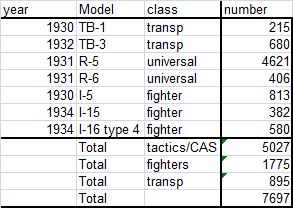Red Army 01.01.1936
Infantry :
77 infantry divisions: 5 - 60% HP, 7 - 50% HP, 8 - 40% HP, 9 - 30% HP, 8 - 25% HP, 4 - 20% HP, 36 - 15% HP (it's real historic peace-time staff of all soviet infantry divisions on this moment, divs with 50-60 HP are all in the Far East border)
9 mountain divisions, 5 - 25% HP, 4 - 15% HP (Formally, USSR has 78 infantry and 8 mountain divisions, but one of the infantry divisions located in the Caucasus was essentially a mountain division in its training, although it is officialy named as infantry. In the future it was transformed into mountain division, so you can implement it on 01.01.1936 as you think to be right.)
31 cavalry divisions (they must be “mechanized cavalry", it included 64 (!) light tanks)
6 separate airborne brigades (airborne divisions with current 10% HP and 30 max_HP) In 1936 it was 6 such embryos, and in 1941 USSR will have 6 'airborne corpses'.
1 garrison + LT brigade (NKVD, Moscow special “Dzerzhinskogo” division)
6 HQ (west military districts)
0 marines! (First soviet marines appeared only in 1940)
Historical names of all divisions (by 1936 year!) and their location on map you can see in my Mod.
-----------
On the summer 1935 Red Army had 22 mechanized Cavalry divisions. From this time it began forming of another 9 Cavalry divisions, which was completed by the summer 1936.
One cavalry division have too few staff (6600 men) to be full division Unit (100 HP) in Game, so cavalry units in my Mod made as
Cavalry Corps with two cavalry divisions in one Unit (6600+6600 =13200 men = Cavalry unit with 100 HP)
So, 31 cavalry division in my Mod realised as 15,5 Cavalry Units.
Also this soviet Cavalry Unit have 64 + 64 = 128 (!) Light Tanks, so it have 70 Softness and high Attack and high Сost.
Mechanized:
There is info that 01.01.36 Red Army consisted 31 tank brigades (25 “mechanized brigades” + 6 “tank brigades”).
(may be 6 “tank brigades” is mistake, because there were only 1,2,4,5,6 numbers of separate tank regiments, i.e. only 5 brigades)
All these brigades were "separate", this means that they were not for 'attaching' to other divisions, but they used for forming LT/tank-divisions or for independent actions.
In particular:
In 1932-1934 years 8 "mechanized brigades" were formed in
4 LT-divisions (4 “mechanized corpses”)
In 1936 year 1 soviet “mechanized corps”= 2 LT-brigades + 1 infantry brigade = 329 LT)
6 “separate tank brigades” with medium T-28 tanks, should be presented as 4 tank divisions with 10% HP (1,4,5,6 OTTBR RGK) and as 1 attached tank brigade (2 OTTBR RGK near Leningrad) and (not sure but just as 'unknown' 6-th tank brigade) 1 T-35 brigade
11 from 25 “mechanized brigades” were still being formed, since summer 1935
(So, all other brigades should be put in Production List as
8 LT-divisions, with 30-60% of completeness)
Finally we have:
4 light tank divisions, 100% HP. (4 real “mechanized corpses”. №: 5, 7, 20, 45)
4 tank divisions, 10% HP. (newest created special separate tank brigades "Command-in-Chief reserve", which will be deployed in tank division in the future: "10 TTBR RGK", "14 TTBR RGK", "20 TTBR RGK", "21 TTBR RGK")
3 light tank divisions, 60% of completeness in Production List.
5 light tank divisions, 30% of completeness in Production List.
(To make other 17 LT-brigades as 6 brigades in pool + 11 under-construction brigades, OR as 8 under-construction LT-divisions is for your taste and choise, I chose the second option just because it makes more sense for gameplay)
0 motorized and no motorized tech! (First soviet motorized infantry divisions appeared only in 1939 )
Attached LT-brigades:
If you hope that all soviet tanks run out you're mistaken

Every soviet infantry and mountain division (in 1936!!) had one “attached” tank battalion.
Because there are no such small units in the game, we must forming these “attached” battalions in standard “attached” brigades.
in 1936 :
1 soviet “infantry” LT-battalion = 42 light tanks
1 soviet “mountain” LT-battalion = 19 light tanks
1 soviet LT-brigade = 3 LT-battalions = 127 light tanks
78 infantry divisions / 3 = 26 LT-brigades
8 mountain divisions * 19 / 127 = 1 LT-brigade
So, Red Army in Hoi2 must have about 26 + 1 =
about 27 “attached” LT-brigades.
Also USSR had about 50 T-35 heavy tanks, i,e. 1 brigade.
Aircraft
I couldn't find the exact information on 01.01.1936 about soviet air force (And about many other countries).
So, I calculated air force of all countries by the number of new aircraft which was produced in last six years: 1930-1935.
USSR:
Of course we need to subtract 20%-30% of these values for loss during exploitation, but also to take into account that other less mass-produced models were also produced.
Therefore I gave to USSR 16 Fighters (100 in one Unit), 36 Bombers (72 in one Unit, R-5,R6), 24 CAS (72 in One Unit, R-5), 4 Navals (72 in One Unit, MBR-2/R-5 and others), 4 Transports (TB-3 in 1941 was outdated and were more often used not as Strategs but as transports).
______________________________
P.S.
To look/check soviet OOB you can in my Mod:
WW2 Multiplayer Realism Mod





